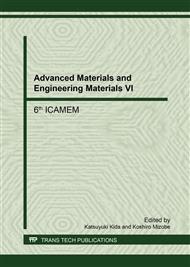p.3
p.7
p.12
p.17
p.22
p.29
p.35
p.39
Effect of Heat Treatment on the Crystal Structure of the Anodic Cerium Oxide Films
Abstract:
The cerium dioxide films were prepared with cerium foils as raw materials by anodization in Na2C2O4-NH3∙H2O-H2O-(CH2OH)2 electrolyte. The anodic cerium oxide films were heat treated in 100~400°C and 0.5~2.5h, respectively. The heat treated anodic cerium oxide films were characterized with X-ray diffraction (XRD). The heat treated anodic cerium oxide film at 100°C is semi crystalline film. The heat treated anodic cerium oxide film at 200°C, 300°C, 350°C, 400°C, respectively for 2h, is the cerium dioxide film respectively, and has a structure of cubic fluorite respectively. The crystal structures of the cerium dioxide films become more complete with the increase of heat treatment temperature in 200 ~ 400 °C. The heat treated anodic cerium oxide film at 400°C for 0.5h, 1h, 1.5h, 2.5h, respectively, is the cerium dioxide film respectively, and has a structure of cubic fluorite respectively. The crystal structures of the cerium dioxide films become more complete with the increase of heat treatment times in 0.5h ~ 2.5h.
Info:
Periodical:
Pages:
12-16
Citation:
Online since:
August 2017
Authors:
Keywords:
Price:
Сopyright:
© 2017 Trans Tech Publications Ltd. All Rights Reserved
Share:
Citation:


